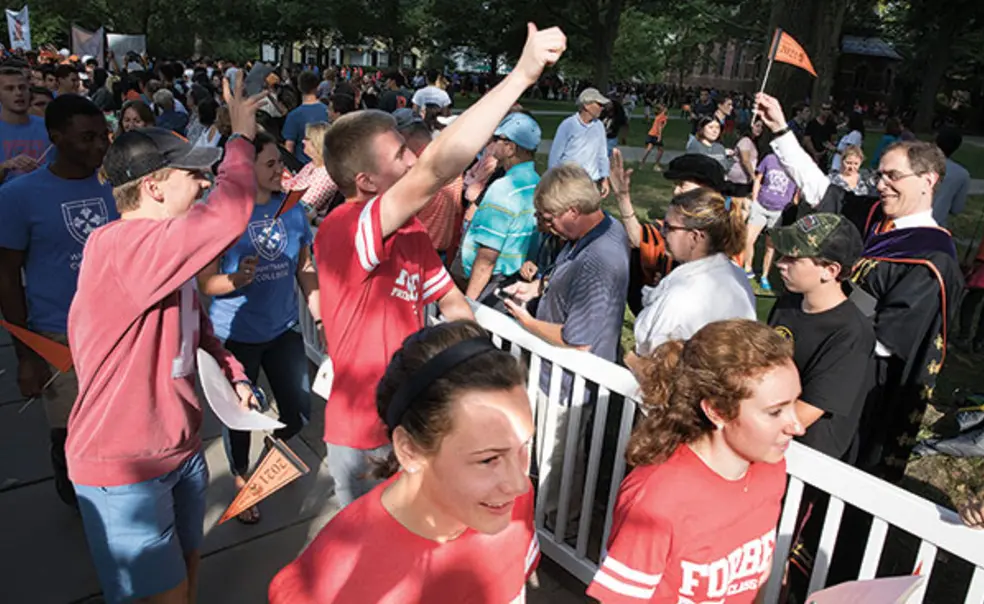Welcome, Class of ’21
Princeton’s most diverse class gets advice on how to disagree in an era of division
The Class of 2021 began its Princeton experience with a bang Sept. 10: 1,306 freshmen waving orange and black class pennants as they walked through the FitzRandolph Gate in the Pre-rade. Amid the day’s excitement, however, students set a more serious tone — one that echoed President Eisgruber ’83’s Opening Exercises talk on “Pluralism and the Art of Disagreement.”
Eisgruber urged the freshmen to learn to disagree and challenge popular opinion through “careful and respectful engagement with views very different from your own.” He drew on the Pre-read selection for the incoming students, politics professor Jan-Werner Müller’s What is Populism?, to bring up the white nationalist protest in Charlottesville, Va., and President Donald Trump’s “equivocating response to it,” which Eisgruber said “troubled me profoundly.” He called on students to “think deeply” about the events and to “participate constructively in the national dialogue they have generated.”
“Some people think that leadership depends upon popularity,” Eisgruber said. “We are committed to leadership through the rigorous and unstinting pursuit of truth.”
Students said they appreciated the focus on how their education is relevant to current events. “Coming to a university as prestigious as this one, it’s important to be politically active and to understand what’s happening in the world,” said Kevin Williams ’21.
Lorenzo Munoz ’21 said he valued Eisgruber’s emphasis on independent thinking “regardless of whether it’s popular or not — and how sometimes it’s even more valuable when it’s unpopular, to have the courage to throw out a dangerous idea that some people won’t like.”
About 400 class members signed an August letter in solidarity with the University of Virginia condemning the “racism, anti-Semitism, and violence that took place” during the Charlottesville protest while lauding UVA for “standing firmly against vitriol and triumphing over hate.”
“As students from a university that has a prominent voice in the academic community, I thought it was important for us [to sign],” said Dana Iverson ’21. “We have that pedestal to comment and show our solidarity.”
Among the orientation events that greeted the freshmen was a new program called Dialogue and Difference in Action, offered, on a pilot basis, as an alternative to Outdoor Action and Community Action. For five days, 40 students gathered with community organizers and activists to discuss issues including racism, sexism, and homophobia.
The program is an expansion of retreats offered in recent years by the Women’s Center, Carl A. Fields Center, and LGBT Center in response to increasing student interest in social-justice issues, according to LaTanya Buck, dean for diversity and inclusion. Isabel Griffith-Gorgati ’21, one of the participants, said that “our mutual interest in social-justice topics we discussed helped us bond.”
The Class of 2021 is Princeton’s most diverse by many measures: race and ethnicity (46.5 percent of U.S. students self-identified as minorities), percentage of Pell Grant recipients (22), and percentage of first-generation college students (17). In addition, for the first time in the University’s history, women in the class outnumber men (Princeton trailed the other Ivies in reporting this).
The Class of 2021
Class size: 1,306
Applicants: 31,056*
Admitted: 1,990 (6.4%**) From waitlist: 101 admitted; 77 enrolled
Yield: 65.6%
Of those enrolled:
Students receiving financial aid: 61%
Women: 50.4%*
Men: 49.6%
U.S. minority students: 46.5%*
International students: 12.5%
Children of alumni: 13%
Recruited athletic prospects: 16.8%
Pell Grant recipients: 22%* From public schools: 60.9%
First-generation college students: 17%*
Number of U.S. military veterans: 5
B.S.E. students: 25.7% (42% are women*)
*a record high
**a record low
Source: Office of Undergraduate Admission
Entering Graduate Students
Doctoral-degree students: 493
Master’s-degree students: 171
Applicants: 10,967
Admitted: 12%
Yield of those admitted: 50%
Men: 59%
Women: 41%
International students: 46%
U.S. minority students: 20% of total (37% of domestic students)
Humanities and social sciences: 55%
Sciences and engineering: 45%
Source: Office of the Dean of the Graduate School; minority and division enrollment figures reported as of June 15
For the record
This percentages for B.S.E. students in the Class of 2021 have been updated to show the figures at the time of enrollment.












1 Response
stevewolock
8 Years AgoFor the Record
The Class of 2021 included 336 B.S.E. students or 25.7 percent of the class at the start of the fall term; 42 percent of the B.S.E. group are women. Figures reported in the Sept. 13 issue were based on information at the time students accepted offers of admission.